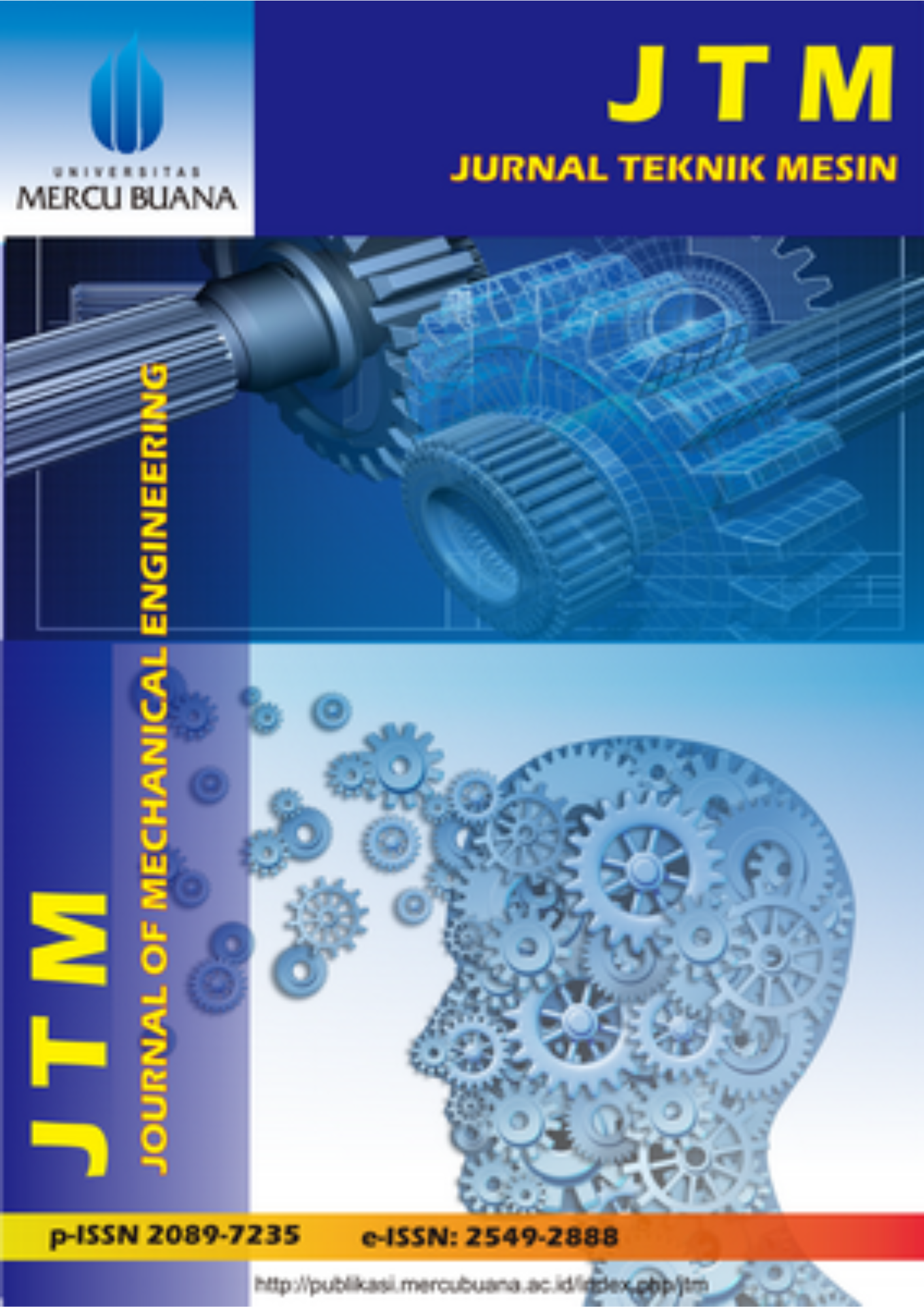The Effect of Reducing Vibration Of Lathe to Aisi 4340 Surface Roughness
Abstract
Keywords
Full Text:
PDFReferences
https://www.andalanfluids.com/ (accessed Jul. 05, 2022).
N. Yusup, A. M. Zain, and S. Z. M. Hashim, “Evolutionary techniques in optimizing machining parameters: Review and recent applications (2007-2011),” Expert Syst. Appl., vol. 39, no. 10, pp. 9909–9927, 2012, doi: 10.1016/j.eswa.2012.02.109.
A. W. Hashmi, H. S. Mali, A. Meena, I. A. Khilji, M. F. Hashmi, and S. N. binti M. Saffe, “Machine vision for the measurement of machining parameters: A review,” Mater. Today Proc., vol. 56, pp. 1939–1946, 2022, doi: 10.1016/j.matpr.2021.11.271.
W. Komatsu and K. Nakamoto, “Machining process analysis of multi-tasking machine tools based on form-shaping motions,” Precis. Eng., vol. 73, no. October 2021, pp. 332–346, 2022, doi: 10.1016/j.precisioneng.2021.10.006.
X. Mu, W. Sun, C. Liu, Y. Wang, B. Yuan, and Q. Sun, “Study on rough surfaces: A novel method for high-precision simulation and interface contact performances analysis,” Precis. Eng., vol. 73, no. April 2021, pp. 11–22, 2022, doi: 10.1016/j.precisioneng.2021.08.017.
H. Akkuş and H. Yaka, “Experimental and statistical investigation of the effect of cutting parameters on surface roughness, vibration and energy consumption in machining of titanium 6Al-4V ELI (grade 5) alloy,” Meas. J. Int. Meas. Confed., vol. 167, no. July 2020, 2021, doi: 10.1016/j.measurement.2020.108465.
R. Chaari, M. Haddar, F. Djemal, F. Chaari, and M. Haddar, “Passive vibration absorber effect on the machining surface quality of a flexible workpiece,” Comptes Rendus - Mec., vol. 347, no. 12, pp. 903–911, 2019, doi: 10.1016/j.crme.2019.11.014.
S. Sun, M. Brandt, and M. S. Dargusch, “Characteristics of cutting forces and chip formation in machining of titanium alloys,” Int. J. Mach. Tools Manuf., vol. 49, no. 7–8, pp. 561–568, 2009, doi: 10.1016/j.ijmachtools.2009.02.008.
D. Yano, S. Ishikawa, K. Tanaka, and S. Kijimoto, “Vibration analysis of viscoelastic damping material attached to a cylindrical pipe by added mass and added damping,” J. Sound Vib., vol. 454, pp. 14–31, 2019, doi: 10.1016/j.jsv.2019.04.023.
S. Yin and N. Rayess, “Characterization of Polymer-metal Foam Hybrids for Use in Vibration Dampening and Isolation,” Procedia Mater. Sci., vol. 4, pp. 311–316, 2014, doi: 10.1016/j.mspro.2014.07.564.
Y. Sun, Z. Song, and F. Li, “Theoretical and experimental studies of an effective active vibration control method based on the deflection shape theory and optimal algorithm,” Mech. Syst. Signal Process., vol. 170, no. November 2021, p. 108650, 2022, doi: 10.1016/j.ymssp.2021.108650.
R. C. HIBBELER, Mechanics of Materials, 8th ed. Pearson Prentice Hall, 2011.
M. Mahendran, “The modulus of elasticity of steel - Is it 200 GPa?,” Int. Spec. Conf. Cold-Formed Steel Struct. Recent Res. Dev. Cold-Formed Steel Des. Constr., pp. 641–648, 1996.
P. R. G. Hein and J. T. Lima, “Relationships between microfibril angle, modulus of elasticity and compressive strength in Eucalyptus wood,” Maderas Cienc. y Tecnol., vol. 14, no. 3, pp. 267–274, 2012, doi: 10.4067/S0718-221X2012005000002.
P. Khatake and P. Nitnaware, “Vibration mitigation using passive damper in machining,” Int. J. Mod. …, vol. 3, pp. 3649–3652, 2013, [Online]. Available: http://files.figshare.com/1605801/BZ3636493652.pdf.
J. Jin et al., “Magnetic-responsive CNT/chitosan composite as stabilizer and adsorbent for organic contaminants and heavy metal removal,” J. Mol. Liq., vol. 334, p. 116087, 2021, doi: 10.1016/j.molliq.2021.116087.
DOI: http://dx.doi.org/10.22441/jtm.v12i3.23663
Refbacks
- There are currently no refbacks.
Copyright (c) 2023 Jurnal Teknik Mesin
Jurnal Teknik Mesin (JTM)
Program Studi Teknik Mesin, Fakultas Teknik, Universitas Mercu Buana
Jl. Meruya Selatan No. 01, Kembangan, Jakarta Barat 11650, Indonesia
Email: [email protected]
Telp.: 021-5840815/ 021-5840816 (Hunting)
Fax.: 021-5871335
JTM is indexed by the following abstracting and indexing services:

This work is licensed under a Creative Commons Attribution-NonCommercial 4.0 International License.






.png)







_(486_x_90_px)_(486_x_190_px)_(486_x_190_px)_(4).png)
_(486_x_90_px)_(486_x_190_px)_(486_x_190_px)_(5).png)
2.png)
.png)